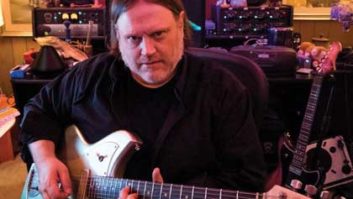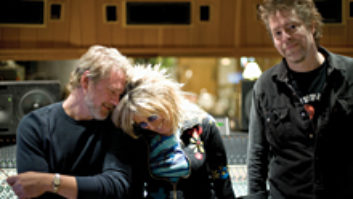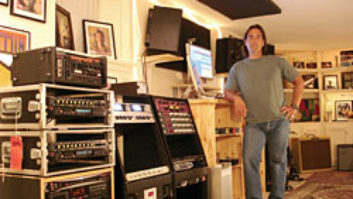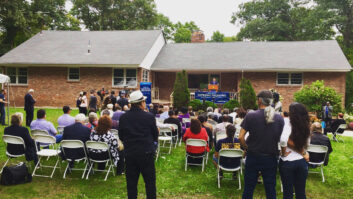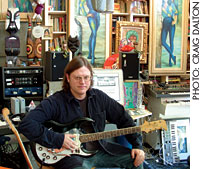
Tucked away in the Hollywood Hills, surrounded by the sites ofcountless hit movie location shoots, is the home and personal studio ofMatthew Sweet. Prolific crafter of acclaimed and successful albums suchas Girlfriend and Altered Beast, along with beingone-third of The Thorns, Sweet’s warm, distortion-drenched guitars,lyrical voice and rock-pop songwriting talents have been a part ofradio, film and concert tours since the mid-’80s. Having worked withtop-level production vets such as Richard Dashut (Fleetwood Mac),Brendan O’Brien (Aerosmith, Train and Bruce Springsteen) and Fred Maher(Lou Reed, Korn), Sweet now has all of the knowledge needed to createnew songs in his own Pro Tools|HD3 — centered personalstudio.
“I was always doing a lot of home recording,” saysSweet. “For me, it was kind of how I got into writingsongs.” Surrounded by a growing collection of ’60s art (he andwife Lisa are in the middle of writing a book on the subject), Sweethas created an inspiring environment that perfectly fits his musicalhistory. With a great selection of vintage amps, originalElectro-Harmonix processors, classic keyboards and an eclecticselection of guitars, there is no lack of unusual equipment. Taking alook into the small room that houses his drum setup, Sweet says thatthe lack of acoustic treatment and angles of the room help him tracksome “crazy, trashy drum sounds.” All other tracking isdone directly in the main room, which also houses his amps, keyboardsand recording gear.
Sweet uses an Apple G4 OS X for his HD system and a Yamaha 02R forstereo playback through Event powered monitors. “We used ProTools for a few mixing things on Girlfriend [1991], my firstbreakthrough record, even though it’s thought of as a real analogrecord. We used it to sequence the record and do little backwardthings; just the stereo [version] was available then. HD made me thinkI could make a record at home, and — even though it’s funkybecause I engineered it and everything — it would beviable.” Although Sweet often uses plug-ins such as the McDSPFilter Bank (“I can’t say enough good things about it”),Chrome Tone and some of the Bomb Factory Pultec and Fairchilds, hisbasic technique also involves Tube-Tech, Neve 1066 and Ampex tubemixers in the input signal chain for instruments. He adds, however,“The beauty of Pro Tools is that you aren’t stuck with one soundgoing in; you can change the plug-ins anytime.”
Sweet doesn’t see the need for bringing in outside engineers, butconfides that most engineers would be aghast at his setup, although itworks best for him. He credits Maher with helping him learn Pro Tools.Playing most of the instruments himself, and using some longtimeaccomplices such as guitarist Greg Leisz and drummer Ric Menck, Sweetdoesn’t need to track using a lot of different inputs. “MikeClark from Southern Tracks [O’Brien’s Atlanta facility] has beenincredibly helpful to me,” he adds. Clark advised Sweet on whatserious gear to obtain and helped him choose some of his classic mics,including a Neumann U49 that he uses for both drums and vocals. Othermicrophones include a Lawson M51 for “all kinds of things”and a selection of various Shure and Sennheisers. He records hisguitars by miking amps and going direct to get “that nice LindsayBuckingham sound.”
Like Buckingham, Sweet prides himself on his self-reliance; in fact,he views it as essential in the current musical climate. “Thefact that you can do [production, marketing and distribution] yourselfmakes for more chance of success. There is so much more out there thatis not being covered well by the majors. It feels like there is kind ofa critical mass of stuff waiting to happen.”
Although he’s still able to go to the majors for new projects, Sweetis exploring different release routes for his two completed personalstudio projects. Kimi Ga Suki, which he describes as a“love letter to Japan,” has been in limited release therethrough a Japanese distributor and in the U.S. on Amazon.com. Alsocoming soon is Living Things, which includes keyboardcontributions from the legendary Van Dyke Parks. Both of these newcollections should be available in wider distribution this summer andperhaps supported by a tour.
“In a way, for me, the art of doing music is really a lotabout the home demo studio,” Sweet offers. “Early on in mycareer, and even in the middle of my career, friends who I know reallywell have always kind of liked my demos better [than the finishedalbums]. Even with the successful records, there’s something about thedemos; they’re just more personal, they’re a little more artistic. Theyjust have that ‘painter on his own’ kind of thing aboutthem.”
Craig Dalton is a Chicago-based freelance writer. Contact himat[email protected].
